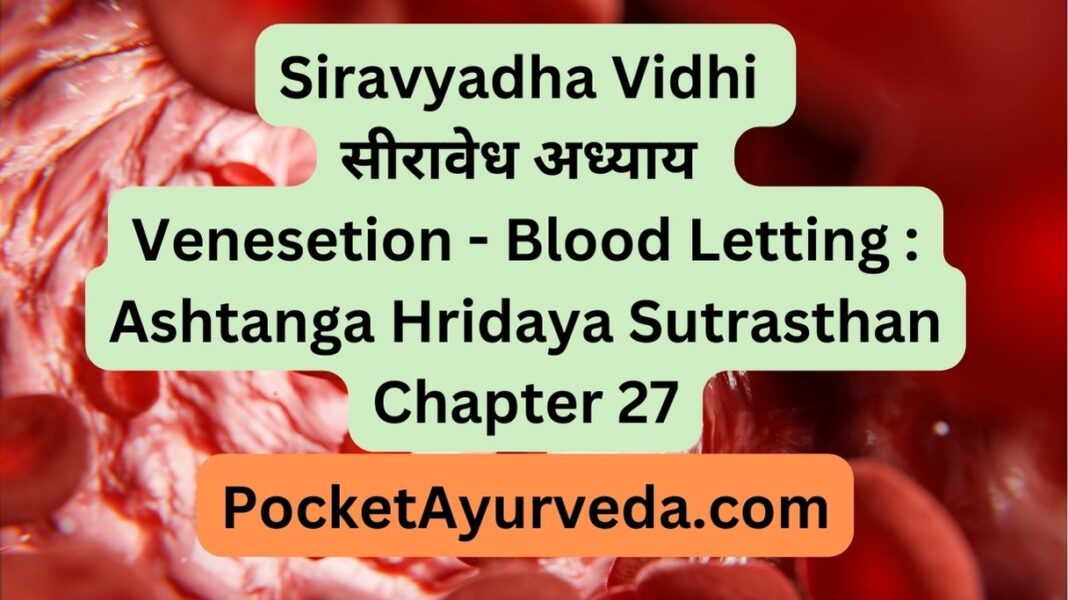We will learn about bloodletting treatment of Siravyadha Ayurveda and its indications, the procedure and side effects, and more. It is chapter 27 in Ashtanga Hrudaya Sutrasthana, written by Acharya Vagbhata, the father of Vaidyapathi Simhagupta. The chapter’s title is Siravadha Vidhi.
Sira means vein. Vyadha means puncturing.
Shuddha Rakta Laksana: The characteristics of pure blood


Shuddha Rakta Laksana- The characteristics of pure blood
A little salty and sweet, taste
Neither hot nor cold,
It resembles the color of lotus Indragopa insect gold, the blood of rabbits and sheep.
These are the main characteristics of pure blood.
It is the reason for the body’s origin, though it determines whether its state is good or bad. 1-1 1/2
The effect of blood that is vitiated – Dushtarakta Karma
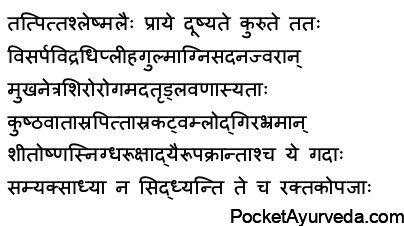

Result of vitiated blood – Dushtarakta Karma
It is common for blood to be vitiated due to Pitta or Kapha.
It causes diseases like
Visarpa– Herpes,
Vidradhi – Abscesses, Pleeha – Disease of the spleen, Splenomegaly Gulma abdominal tumors Agnisadana and Dyspepsia,
Jvara – fever Mukha, Netra Shiroroga – disorders of the eyes, mouth, and head; Mada – alcoholism- toxic effects,
Trut, excessive thirst Lavanasyata Salty taste in the mouth,
Vatasra- Gout,
Pittasra- bleeding disorder,
Belching out with strong and sweet flavors and dizziness.
Curable diseases that are not being treated even after a suitable cold or dry, hot, or unctuous treatment should be considered as the result of aggravated blood. 1 1/2- 4 1/2


They should be cut to eliminate the blood vitiated in the veins affected by these diseases. 5
Individuals who aren’t suitable for venesection Siravyadha Ayogya
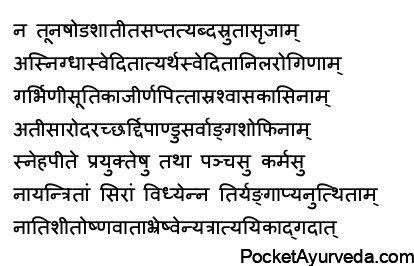

Persons unsuitable for venesection – Siravyadha Ayogya
Aged less than 16 and over 70 years of age.
people who have never had to bleed before – at any time for any reason,
those who have had to undergo excess Snehakarma and sweating treatments,
people suffering from ailments caused by Vata source,
the woman who is pregnant,
the woman with parturition
people suffering from those suffering from bleeding disorders, indigestion, Shwasa (dyspnoea),
Kasa – cold, cough
Atisara – diarrhea, dysentery
Udara – ascites, intestinal obstruction/ expansion of the abdomen
Chardi – Vomiting
Pandu Anemia
Chardi – Vomiting,
dropsy;
for people who have received fats – oil or ghee to drink as part of oleation therapy and are currently undergoing the treatment known as Panchakarma.
The vein shouldn’t be cut without controlling the body. Explained further.
The horizontal vein, the one that is not raised and not during extremely cold, very hot, extremely windy, or cloudy days, venesection shouldn’t be performed. 6-8 1/2
Choice of the place of venesection- Vyadhana Sthana Nirdesha
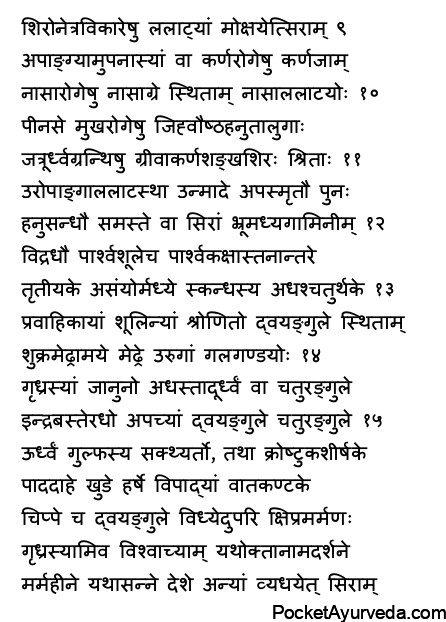

Selection of site of venesection- Vyadhana sthana nirdesha
When there are head-related diseases and eye, veins that are located at the front of the head, the outer angle of the eyes, or the region around the nose must be cut.
In the case of ear infections in ear infections, the veins around the ear are affected;
In nose-related diseases with nasal diseases, veins located near the tip of the nose;
in Rhinitis, the vein is located between the forehead and nose in Jaw or the palate.
in tumors that affect the upper part of the shoulders, and a vein that is located in the lips or tongue in tumors of the lower Jaw or the palate;
In tumors, there are parts over the shoulder, the veins in the temples, neck, ears, or the head in the Jaw;
for all disorders of the head, it is usually a vein between the eyebrows.
The cause is Vidradhi (abscesses), discomfort in the flanks, vein located between the flanks Axilla and the breasts, and
fever that occurs on the third or fourth day (Truteeyaka). The vein is located in the middle of the shoulders.
with fever on each fourth day (chaturthaka) in a fever that lowers the armpits;
In dysentery, pain veins are located in two Angula to the left of the pelvis.
Semen-related diseases and penis veins situated in the penis
in the glandular expansion in the neck (Apachi) neck glandular enlargement (Apachi), which is situated in the thigh.
In the Gridhrasiin Gridhrasi, the sciatica vein is located at the bottom of four Angula, below or above knee joints;
In the Apachi (goiter) in the Apachi (goiter) vein that is situated around two Angula below the Indra Basti, an essential point in the middle of the muscles of the calf;
In thighs that hurt as well as Krostukasira (inflammatory pain in the knee joint), Daha of the soles, Khuda (gout), Padaharsa(gout), Padaharsa (tingling sensation in the feet), Vipadika – fissures of the feet, Vatakantaka (sprain of the ankle/foot) along with Chippa (A disease of the toenails) The vein is located just two Angulas above the Kshipramarma- the vital spot between your big toe, and next;
In Vishvachi – pain in the arms in the same manner as in Gridhrasi Sciatica must be treated.
If the veins appear to be hot apparent, a vein located nearby and free of vital spots must be cut. 9-17
Siravyadha Vidhi – Venesection – bloodletting procedures and rituals
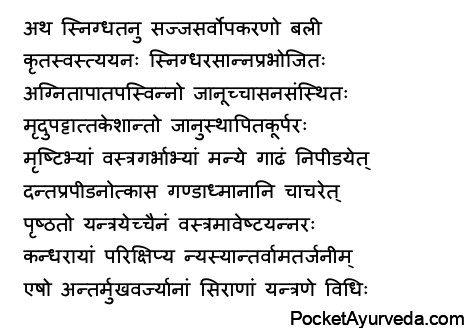

Siravyadha vidhi- Venesection – bloodletting rituals and procedure
The patient should undergo the Snehana procedure.
All necessary equipment must be prepared.
The person should be sturdy and able to perform auspicious rituals and eat meat juice and boiled rice with ghee.
The patient must be exposed to light or to fire to sweat.
He will be asked to sit on a stool at the height of his knee.
A soft band is to be tied around the hair at the lower end of the hairs.
Keep elbows on his knees.
The neck was massaged vigorously using fists, and pads of cloth are healed;
Coughing, grinding the teeth, or inflating the mouth to increase the size of the cheeks must also be performed by the body.
The trunk should be tied with an elastic band and controlled with knots in the back of the trunk;
The neck should be tied with a piece of fabric, and then the neck should be tightened.
This is the process of raising deep-seated veins.18-22
Bloodletting Procedure
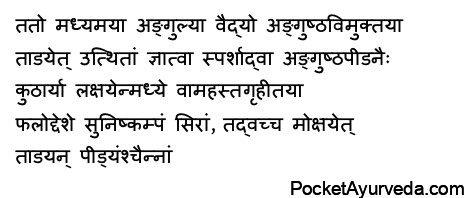

The doctor should then tap the vein that has been raised with his middle finger that his thumb has snared off, noting the elevation or raising it more by pressing it using the thumb.
Then, while holding the Needle in the left hand, position its edge in the middle of the vein. Then give up the Needle without shaking.
Needle should be lifted similarly by tapping and kneading the vein to encourage more blood to flow out. 23-24
Siravedhana of nose


The veins of the nose need to be cut using the Vrihimukha Sastra which is the Lancet, with its face formed as a grain of rice after raising the tip and the areas close to the thumb. 25
Siravedhana of tongue


The vein underneath the tongue should be cut by insisting that your patient maintain the point of the tongue up by biting it while firmly securing it with one of the teeth on top. 25 1/2
siravedhana of neck vein


To cut the veins in the neck area, these must be elevated by manipulating the region over the breasts. The patient is instructed to put the stone with his fists and then keep the shoulders on their knees with the stretched outwards;
the body is massaged, beginning with the stomach pit towards the upward direction, and afterward, the vein can be cut. 25 1/2- 27
siravedhana of hand veins
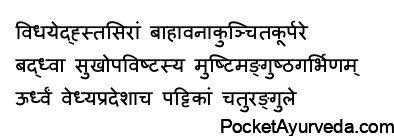

The veins of the hand are cut when the patient is comfortably seated, maintaining his hand straight, without bent elbows by clenching one of the fingers folded inwards and a piece of fabric tied, four Angula above the cutting location. 28-28 1/2
siravedhana of flanks


The veins on the flanks should be cut by keeping the arms free;
These are the painful areas when the leg is swollen or Achylocarpine when the leg is 4 Angula above the point of cutting. 29-29 1/2
siravedhana of leg veins
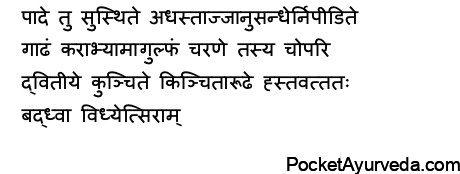

The veins of feet are cut. If the feet remain in place and the foreleg is massaged quickly from the knee down towards the Ankle using the hands, using a band similar to the hand method described while the other leg is left slightly bent. 30-31
Methods of siravedhana


The wise doctor must use methods to increase the veins that are appropriate for the locations, using methods that aren’t mentioned in this article. 32


On the fleshy parts Of bones, it is recommended that the Vrihimukha Sastra (Lancet) should be utilized with the vein cut in the shape of a grain of rice only. The veins on bones must be cut to the size of half of a (Yava) barley with the Axe. 33
Samyak Viddha Lakshana – samyak siravedhana Lakshana


Samyak Viddha Lakshana / samyak siravedhana Lakshana
If the cut is done correctly, it will flow continuously and stop once you release the controls (tourniquet) is let go.
Asamyak Viddha Lakshana – Asamyak Siravedhana Lakshana


Asamyak Viddha Lakshana / Asamyak Siravedhana Lakshana
If the cutting isn’t adequate, the blood flow is only for a brief period and is less than the quantity. Then, it is suggested to rub using lime and oil powder to encourage more bleeding.
Ati Viddha Lakshana – Ati siravedhana Lakshana


Ati Viddha Lakshana – Ati siravedhana Lakshana
If the cut is more extensive, the blood oozes out in a loud sound and then ceases without difficulty. 34
Asruti Karana: the reasons for non-flowing Causes for not flowing


Fear and fainting, loss of tourniquet, sharp instruments, excessive satiation (excess eating), debility, urges for urine, feces, and so on, and insufficient sweating therapy are the main reasons for the absence of blood flow. 35


If blood is not flowing sufficiently, the cut portion of the vein must be smeared with oil formulated by Vella (Vidanga), Vyosha (Trikatu), Haridra, Nata, Agaradhuma, or Lavana. The vein should be covered in warm salt and oil when blood flows appropriately. 36-37
Vitiated blood flows out first in Siravedhana


The blood that is vitiated flows first, similar to the yellow-colored juice that forms two seeds from Kusumbha before the oil is released.


After sufficient bleeding occurs, it ceases on its own; it must be considered pure, uncontaminated blood, and any other flow is not to be monitored. 38
Pateint fainted during Siravedhana


If, at the moment that bleeding occurs, the patient falls, unconscious when the tourniquet is released, the patient should be removed, and fans must surround him to awaken him, and the bleeding should continue. Bloodletting must be delayed until the next or third day if he continues to faint. 39
Dushtarakta Lakshana – the characteristics of blood that is impure


Dushtarakta Lakshana- characteristics of contaminated blood
Blood vitiated through Vata is usually colored in crimson or blue dry, and nonslimy. It is clear and frothy.


The pitta-contaminated blood will appear black or yellow and has a foul odor. Not as thick due to the increase of heat, and is it glistening with particles.


When it is vitiated, the blood of Kapha will be an unctuous pale yellowish-white hue and has tiny threads thin and slimy;


In the event of a combination of two Doshas, it will result in mixed characteristics. Blood that all Doshas vitiate will appear dirty and dense. 40-41
Srava Pramana – Quantity flow


Blood that is contaminated with vitiated more than one Prastha (or (768 ml) must not be allowed to leak out even in highly stout individuals;
The excess bleeding can cause death or terrible vata-related diseases.
Oil massage and drinking milk mixed with blood is the best treatment. 42
Siravedhana paschyat karma


Following the blood flow will stop, the blood vessels must be removed gradually, and the area must be cleaned with cold water; the vein’s cut ends are covered by a cotton swab that has been soaked in oil and then bandaged. 43
repeat siravedhana


The vitiated blood should be removed and re-evaluated the same night or the next day if the blood is exceedingly vitiated and has more Doshas.
Removing it within a few weeks after administering Snehana therapy is recommended. 44


If a small amount of vitiated blood is found inside the disease, it will not be worse, and it can remain; however, excessive blood flow shouldn’t be considered. 45
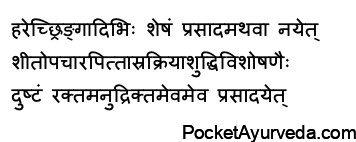

This blood can be removed through the usage of the sucking Horn (Shrunga)etc. or it could be cleansed of doshas with cold comforts, therapy that is prescribed for Raktapitta (bleeding ailments) as well as purification therapies (Panchakarma), and so on. and through methods to make the body slim.
Even blood that has been slightly contaminated due to the Doshas but is not increasing in size must be treated with these techniques. 46-47
Stop bleeding in Siravedhana


If the bleeding isn’t able to cease, measures to stop it must be implemented. The orifice of the wound must be covered with the powder of Rodhra, Priyangu, Pattanga, Masha (black gram), Yashti (licorice), Gairika, Mritkapala (pot shred), Kshana Masha, the ash of flax or the sprouts and bark of trees containing milky Sap through a cold infusion derived using the medicines of Padmakadi Gana – vide chapter 15 should be considered as a drink.
The vein that was cut previously should be cut again, and the ends of the vein must be joined by a red hot rod. (cautery) using the help of a red rod. 48-50
Application of tourniquet in siravedhan karma


If a tourniquet is applied, the Doshas may temporarily become aggravated and spread to other areas within the human body.
After removing the tourniquet, the doshas will return to their regular locations. However, until then, it is removed; one must eat only healthy diets and other activities. 51
Diet after siravedhana


Foods that aren’t extremely cold, hot, or very hot and are also easy to digest (accessible to digest) and stimulate appetite are suitable for removing blood.
This is because, following the bloodletting, the body is unsteady and has a low digestion level. 52
The characteristics of those with Non-vitiated Pure – Healthy Blood


Features of Persons with Non-vitiated (Pure/Healthy) Blood
The best color and appearance and improved performance of the sense organs, an excellent perception of objects through sense organs, good digestion activity, and enjoyment of the pleasures backed by excellent nutrition and immunity are the hallmarks of the person with non-vitiated blood. 53
This chapter is titled Siravyadha Vidhi. The 27th Chapter is Sutrasthana of Astanga Hrudaya.


